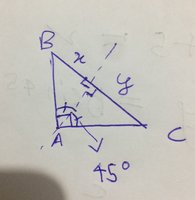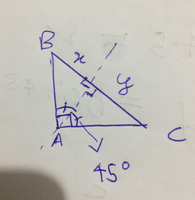alevelsprivately
New member
- Joined
- Aug 12, 2019
- Messages
- 2
Hi!
This is my first post on this website, so lets stick to constructive criticism.
Thanks
I was trying to prove Pythagorean Theorem myself, I drew this triangle

(just a reference)
Its basically a right angle triangle with a perpendicular angle bisector.
From here what I do is get divide BC into BD = x and DC = y
Now using trig (stupid for this proof but...)
x = ABsin45 = AB/[MATH] \sqrt{2} [/MATH]y = ACsin45 = AC/[MATH] \sqrt{2} [/MATH]
so as BC = x+y
[MATH]BC = (AB + AC)/ \sqrt{2} [/MATH]
now squaring both sides
[MATH] BC^2 = (AB+AC)^2/2 [/MATH]
or more generally
[MATH] h^2 = (a + b)^2/2 [/MATH]
Now out of curiosity I tried this out on the 3-4-5 right angled triangle
and I got
[MATH]\sqrt{(3+4)^2/2} = 4.95 [/MATH]
which is pretty close to 5
----------------------------------------------------------------------------------
Now my question is,
Can anyone explain me what relationship have I found between these variables or am I just pondering upon a special case
or maybe just a bad way to prove Pythagorean theorem. I am pretty confused as to what this is.
Also, if I have gone wrong somewhere please correct me.
Thanks again for all the help
This is my first post on this website, so lets stick to constructive criticism.
Thanks
I was trying to prove Pythagorean Theorem myself, I drew this triangle

(just a reference)
Its basically a right angle triangle with a perpendicular angle bisector.
From here what I do is get divide BC into BD = x and DC = y
Now using trig (stupid for this proof but...)
x = ABsin45 = AB/[MATH] \sqrt{2} [/MATH]y = ACsin45 = AC/[MATH] \sqrt{2} [/MATH]
so as BC = x+y
[MATH]BC = (AB + AC)/ \sqrt{2} [/MATH]
now squaring both sides
[MATH] BC^2 = (AB+AC)^2/2 [/MATH]
or more generally
[MATH] h^2 = (a + b)^2/2 [/MATH]
Now out of curiosity I tried this out on the 3-4-5 right angled triangle
and I got
[MATH]\sqrt{(3+4)^2/2} = 4.95 [/MATH]
which is pretty close to 5
----------------------------------------------------------------------------------
Now my question is,
Can anyone explain me what relationship have I found between these variables or am I just pondering upon a special case
or maybe just a bad way to prove Pythagorean theorem. I am pretty confused as to what this is.
Also, if I have gone wrong somewhere please correct me.
Thanks again for all the help


